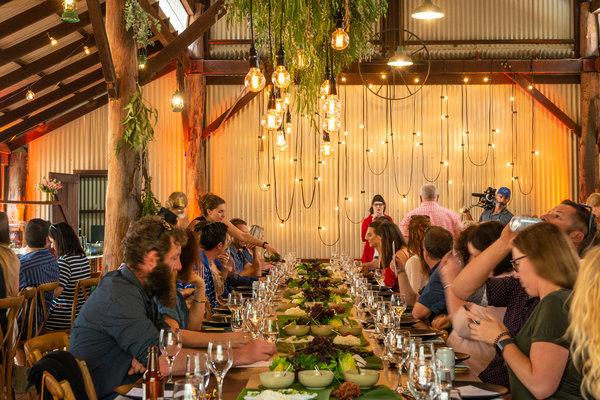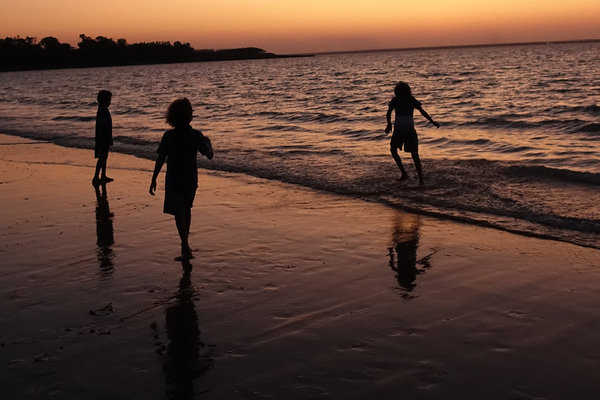The late afternoon sunlight in Western Australia’s Margaret River region is deeply golden, casting its buttery hue across vineyards and filtering through the forests of giant karri trees. Sometimes the landscape looks almost European, with roads tunneled by groves of old trees next to fields of baled hay. Then you spot a herd of Western Gray kangaroos lounging beneath the trees, or turn a bend in the road and there it is: the shocking aqua blue of the Indian Ocean.
It’s not hard to see the appeal. But given its remoteness, it is somewhat surprising that the area to the south of Perth, Western Australia’s capital city, has become a popular destination for food and wine tourists.
There is no doubt that the region has all the elements needed to draw hungry (and thirsty) tourists. It is stunningly beautiful, and while it is one of the youngest established wine regions in the world (at around 50 years old) it is quite robust, with close to 100 wineries. But it is hardly the only naturally stunning wine-producing region in Australia, and many are older and easier to access. And yet tourism to Margaret River and the surrounding area has exploded, with the number of international visitors up by 37 percent in just the last three years.
How did they do it?
Australia has tilted its tourism strategy toward culinary offerings, not just its cute and fuzzy animal population. Central to the tourist boom in Western Australia is the Margaret River Gourmet Escape, a major food and wine festival.

Patrons enjoy a Vietnamese-inspired lunch inside an old barn on the Leeuwin Estate Winery, as part of the Gourmet Escape festival.CreditGraham Miller for The New York Times
But first, how remote is it?
Imagine a third of the contiguous United States — let’s say everything west of the Rockies — as one single state. That is approximately the size of Western Australia, which takes up just under a million square miles of the country’s 2,941,300-square-mile area. Now imagine that the entire vast expanse is populated by less than three million people, with more than half of those people living in one city.
Perth is already one of the most remote state capitals in the world, a five-hour flight from Sydney or Singapore (there are no direct flights from the U.S.). Margaret River, the small town that anchors the wine region of the same name, is another three-hour drive from Perth.


How did the festival end up there?
A decade ago, Perth was in the midst of a mining boom, and its hotel rooms were filled almost to capacity. State tourism officials were looking for a way to get visitors to travel beyond the capital city. At the same time, Brand Events — best known for its “Taste of” festivals in various cities — was searching globally for a location for its next big food festival. (Brand Events has since been acquired by IMG, a worldwide sports, fashion and events company.)
The Margaret River Gourmet Escape was launched in 2011 and has returned to the region every November since, drawing more that 20,000 attendees in 2018. The festival, which has events spread across the region, consists of wine dinners, parties, book signings and a central “gourmet village” at one of the major wineries, with a main stage for cooking demonstrations and talks.
One of the festival’s keys to success has been its ability to draw top-tier talent, and chefs come from around the world to participate. In 2018, Nigella Lawson was the headliner of the Gourmet Escape, all the while sharing dreamy photos of the event with her 1.4 million Instagram followers.
The 2018 festival pretty much looked like this: Ms. Lawson in a long flowing dress on a beach at sunset, toasting a crowd of tipsy revelers. The water was calm and almost electric blue, the beach was adorned with huge canvas tents with lounging areas, waiters carried platters of grilled prawns and pretty cocktails, and strings of twinkling lights made everyone seem a little more attractive than they really are.
Tickets for events are sold separately, and accommodation in the area can be pricey, particularly during the festival; attending is an expensive endeavor, even before you’ve factored in the travel involved. But the yearly gathering of media, chefs and moneyed food obsessives has helped to boost the profile of Margaret River exponentially.
What’s there besides the festival?
The Margaret River winegrowing region is surrounded by state forests and national parks, and outdoor activities are practically limitless. Along the coastline, the Leeuwin-Naturaliste National Park stretches from Cape Naturaliste to Cape Leeuwin, and the 76-mile Cape to Cape Track is a bucket-list trail for many Australian hikers. Hugging the coastline and with near constant views of the Indian Ocean, the trail takes between four and eight days to hike, depending on how you go about it.
Most hikers go old-school, packing their own food and stopping to camp wherever they find space. But there are companies that will guide you and arrange transportation, accommodation and food, and high-end hotels, spas and restaurants are just off the track. One company, Walk Into Luxury, offers guided tours with daily transport to and from the trail, gourmet meals and accommodation at Injidup Spa Retreat, where villas with personal spa pools overlook the ocean.
Hotels?
Injidup has one of the most dramatic settings of any Margaret River accommodation option, but it is hardly alone in the ultraluxury hotel game. Farther north along the Cape to Cape Track is Smiths Beach Resort, which looks out over a well-known surf beach and offers everything from two-room cabins to four-bedroom beach houses. Inland, Forest Rise Chalets has free-standing cabins that are nestled into a fairyland-like forest, where kangaroos lope through the trees right in front of your bedroom window. There are also many glamping companies in the area.
Budget options are plentiful, as well. Campsites abound, including in the region’s many national parks. Just a little way up the coast from the luxe Smiths Beach Resort is Yallingup Beach Holiday Park, where cabins rent for as little as 90 Australian dollars per night, or about $63, and campsites are even cheaper. The town of Margaret River is home to a host of cheerful motels with reasonable rates.
And what about restaurants?
Margaret River’s restaurant scene is also experiencing a boom, much of it hand in hand with the wine industry, as vineyards learn that the dining room can be as much of a draw as the cellar. Two of the region’s best-known wineries, Vasse Felix and Cullen Wines, are also home to two of the state’s most highly awarded restaurants.
But there are wonderfully unexpected finds as well, including Miki’s Open Kitchen, a high-end tempura restaurant in a former beauty parlor in the back of a shopping strip on Margaret River’s main street. The chef, Mikihito Nagai, has lived in Western Australia for 22 years, and was drawn to Margaret River 12 years ago in part because it’s a great place to surf. In 2013, with tourism on the rise, he saw an opportunity to open something the region hadn’t seen before, and Miki’s Open Kitchen was born.
These days, Perth’s hotel rooms aren’t quite as full as they were a decade ago. Western Australia’s tourism board and IMG are both looking for ways to expand the success of the Gourmet Escape, and shine light on other areas of the state. In 2019, the festival will expand from four to 10 days, and events will take place in Perth, Margaret River and the Swan Valley, a winegrowing region just northeast of Perth.





